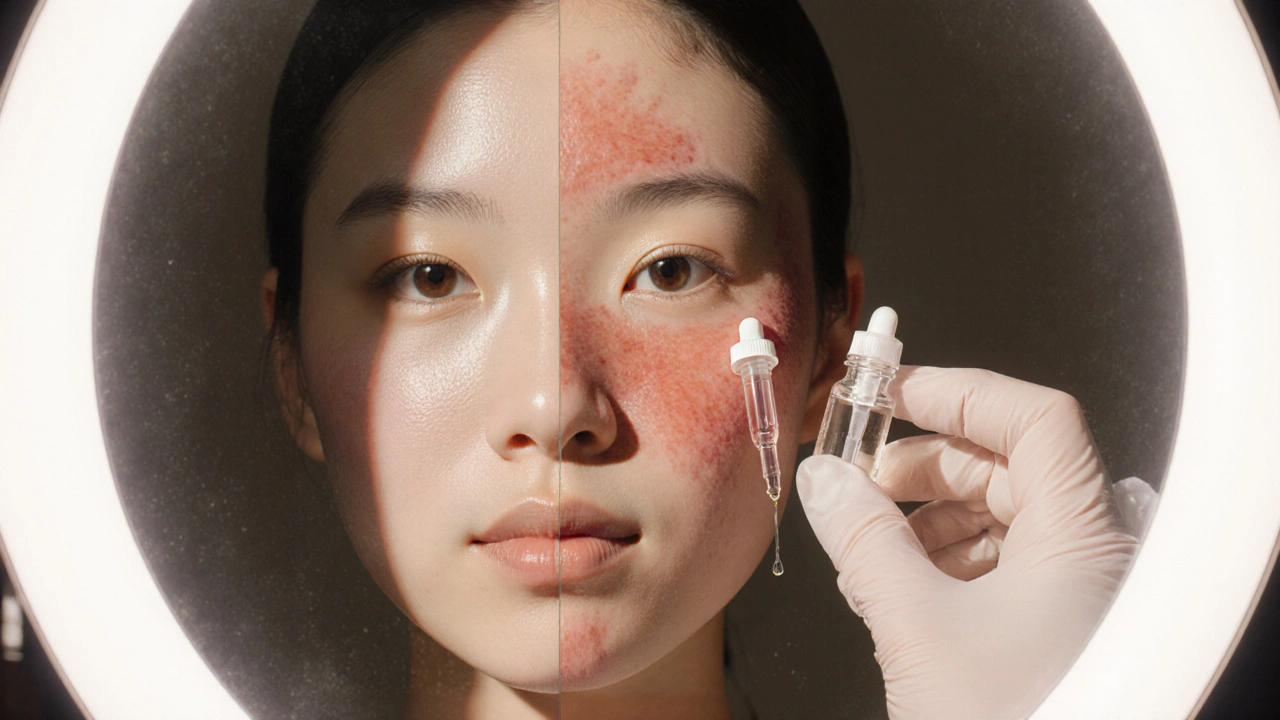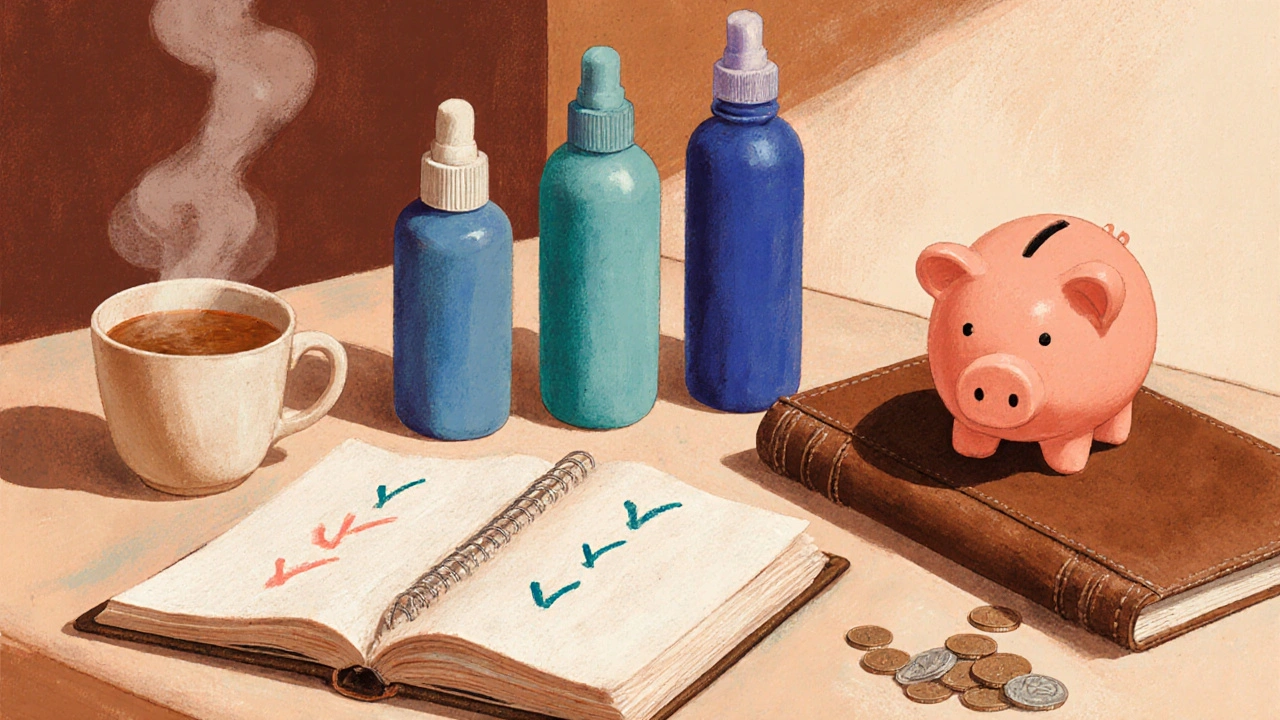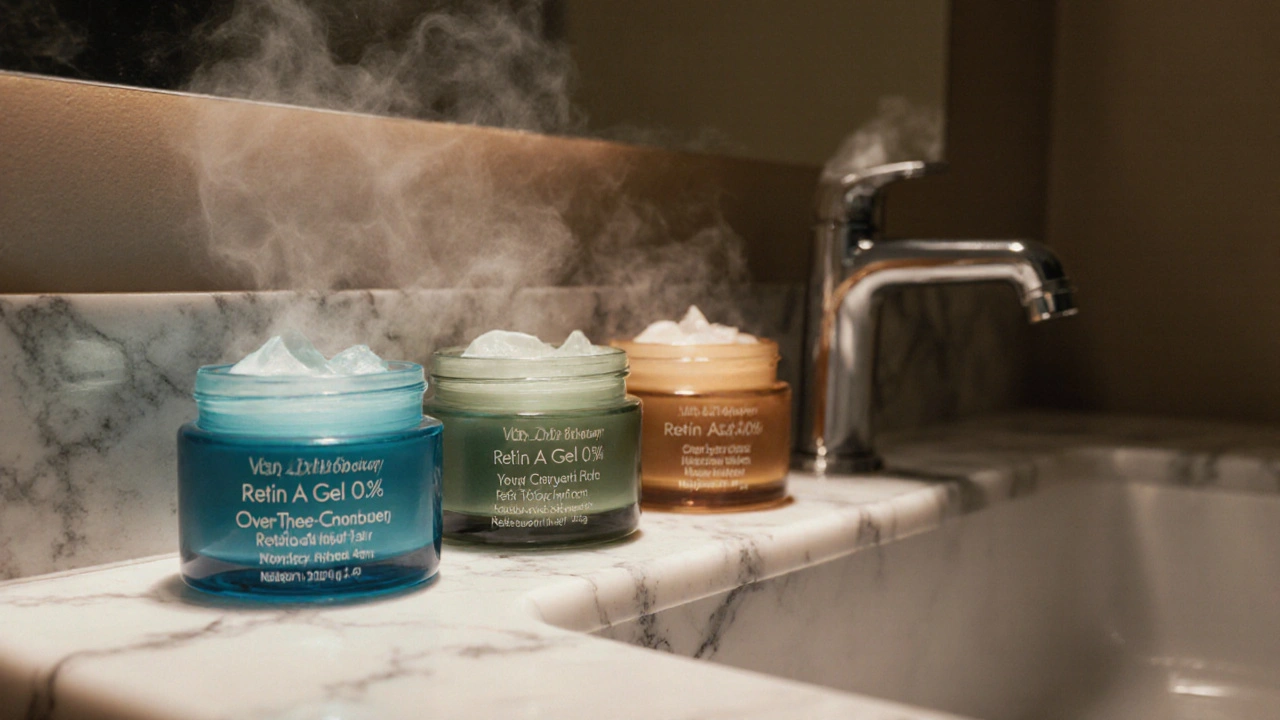Retinoid Choice Advisor
Choose Your Skin Profile
Retin A Gel 0.1 is a prescription‑strength tretinoin gel (0.1% concentration) used to treat acne, fine lines and hyperpigmentation. If you’ve ever wondered whether it lives up to the hype or if there’s a milder over‑the‑counter option, you’re in the right place. This guide breaks down how tretinoin works, weighs its pros and cons, and lines it up against the most popular alternatives on the market.
Key Takeaways
- Retin A Gel 0.1% is the most potent prescription retinoid available in gel form.
- Adapalene 0.1% (Differin) offers similar acne benefits with less irritation for most users.
- Retinol serums are gentler but require longer treatment periods to see results.
- Azelaic acid and tazarotene serve niche needs - azelaic for rosacea‑prone skin, tazarotene for severe acne or deep wrinkles.
- Cost, prescription requirement, and side‑effect profile are the three main decision factors.
What Is Retin A Gel 0.1?
Retin A Gel 0.1 is a topical formulation of tretinoin at a 0.1% concentration, delivered in a lightweight gel base. It belongs to the retinoid family, which are vitaminA derivatives that increase cell turnover and stimulate collagen production. Dermatologists prescribe it for:
- Moderate to severe acne vulgaris
- Photodamage (sun‑spots, uneven texture)
- Fine lines & early‑stage wrinkles
The gel texture is intended for oily or combination skin because it absorbs quickly without leaving a heavy residue.
How Tretinoin Works
Tretinoin binds to retinoic acid receptors (RAR‑α, β, γ) in the nucleus of skin cells. This triggers a cascade that:
- Speeds up desquamation - dead skin cells shed faster.
- Prevents clogged pores - reduces comedone formation.
- Boosts fibroblast activity - more collagen and elastin.
- Normalises melanin distribution - fading dark spots.
Because it acts at the genetic level, the effects are powerful but also come with a higher irritation risk, especially during the first 4‑6 weeks (often called the “retinoid purge”).

Top Alternatives to Retin A Gel 0.1%
Below are the most widely‑used retinoid or retinoid‑like options, each with its own sweet spot.
1. Adapalene 0.1% Gel (Differin)
Adapalene 0.1% Gel is a synthetic retinoid that targets acne‑related inflammation. It is available over the counter in many countries. Compared with tretinoin, adapalene has a slower penetration rate, which translates to milder redness and peeling for most users. Ideal for beginners or those with sensitive skin who still need anti‑acne power.
2. Tretinoin Cream 0.05%
Tretinoin Cream 0.05% contains half the active concentration of Retin A Gel 0.1% but in a richer, emollient base. It’s better for dry or mature skin because the cream reduces transepidermal water loss. Efficacy is comparable if you apply it consistently, though results may appear slightly slower due to the lower dose.
3. Retinol Serums (0.5%-1%)
Retinol Serum 0.5% is an over‑the‑counter vitaminA derivative that must be converted by the skin into active tretinoin. This extra conversion step makes it gentler but also less potent. It’s a good entry point for anti‑aging routines; expect visible improvement after 12‑16 weeks rather than the 4‑8 weeks typical of prescription tretinoin.
4. Azelaic Acid 15% Gel
Azelaic Acid 15% Gel isn’t a retinoid, but it offers anti‑acne and skin‑brightening benefits with virtually no irritation. It’s especially useful for rosacea‑prone or hyperpigmented skin where tretinoin might exacerbate redness. It also has antibacterial properties against *Propionibacterium acnes*.
5. Tazarotene 0.1% Cream
Tazarotene 0.1% Cream is a third‑generation retinoid with strong anti‑acne and anti‑photoaging effects. It’s the most potent topical retinoid in the market, reserved for severe acne or deep wrinkles. The trade‑off is a higher likelihood of intense peeling and strict sun protection demands.
Side‑Effect Profile Comparison
Understanding how each product irritates (or doesn’t) can save you weeks of frustration.
| Product | Prescription? | Typical Concentration | Primary Benefits | Irritation Level* | Average Cost (NZD) |
|---|---|---|---|---|---|
| Retin A Gel 0.1% | Yes | 0.1% | Acne, fine lines, hyperpigmentation | High | ≈$70 per tube |
| Adapalene 0.1% Gel | No | 0.1% | Acne, mild anti‑aging | Medium | ≈$30 per tube |
| Tretinoin Cream 0.05% | Yes | 0.05% | Dry/mature skin, acne | Medium‑High | ≈$55 per tube |
| Retinol Serum 0.5% | No | 0.5% (converted) | Anti‑aging, texture | Low | ≈$45 per bottle |
| Azelaic Acid 15% Gel | No | 15% | Acne, rosacea, pigmentation | Low | ≈$35 per tube |
| Tazarotene 0.1% Cream | Yes | 0.1% | Severe acne, deep wrinkles | Very High | ≈$80 per tube |
*Irritation level is a relative rating based on clinical trial data and patient surveys (Low=<10% report redness; Medium=10‑30%; High=30‑50%; Very High=>50%).
Choosing the Right Retinoid for Your Skin
Here’s a quick decision tree you can follow:
- Do you need a prescription? Yes → Retin A Gel 0.1% or Tretinoin Cream 0.05%.
No → Look at over‑the‑counter options. - Is your skin oily/combo and you’re chasing acne?
Go with Adapalene 0.1% or Retin A Gel 0.1% (if you can tolerate irritation). - Is dryness or sensitivity your main concern?
Choose Retinol Serum 0.5% or Azelaic Acid 15% Gel. - Do you need aggressive anti‑aging for deep wrinkles?
Tazarotene 0.1% (prescription) or Retin A Gel 0.1% if you can handle the purge.
Factor in cost and how often you’re willing to see a dermatologist. For most people, starting with an OTC retinoid and stepping up only if needed saves both money and skin stress.
Common Pitfalls & Pro Tips
- Don’t over‑apply. A pea‑size amount for the whole face is enough. More product doesn’t speed results; it just raises irritation.
- Always use sunscreen (SPF30+). Retinoids thin the stratum corneum, making UV damage more likely.
- Introduce the product slowly - start with two nights a week, then ramp up as tolerated.
- Pair with a gentle moisturizer. Look for ceramide‑rich formulas that won’t clog pores.
- Avoid other strong actives (e.g., AHAs, benzoyl peroxide) in the same routine unless you’re a seasoned user.

Frequently Asked Questions
Can I use Retin A Gel 0.1% if I’m pregnant?
No. Tretinoin is classified as pregnancy‑category C and has been linked to fetal malformations. Switch to a safe alternative like azelaic acid during pregnancy.
How long does it take to see results with Retin A Gel?
Most patients notice smoother texture and reduced breakouts after 4‑6 weeks, but significant pigment fading can take 3‑6 months of consistent use.
Is Adapalene as effective as tretinoin for acne?
Clinical studies show Adapalene 0.1% clears mild‑to‑moderate acne nearly as well as tretinoin 0.05%, with a lower irritation rate. For severe nodular acne, tretinoin still has the edge.
Can I combine Retin A Gel with a retinol serum?
It’s not recommended. Both act on the same pathway and can overwhelm the skin, leading to severe peeling. Choose one retinoid at a time.
What’s the best way to store Retin A Gel?
Keep it in a cool, dark place - ideally a bathroom cabinet away from direct sunlight. Heat can degrade tretinoin potency.


Matthew Holmes
The pharma giants hide the true potency of Retin A behind red tape
Patrick Price
I think the whole thing about tazrntoe versus adapalene is overblown people dont read the fine print of the label
Travis Evans
Look, start with a pea‑size dab every other night and watch how your skin clears up – it’s like giving your face a fresh start every time you apply.
Jessica Hakizimana
When you stare at the list of retinoids it feels like you’re choosing a path in a choose‑your‑own‑adventure novel, each option promising a different kind of glow. The most potent, Retin A Gel 0.1%, is like the heavyweight champion – it can knock out acne fast, but it also throws a lot of punches at your skin’s barrier. That’s why beginners often start with a gentle retinol serum; it’s the training wheels of the retinoid world. Think of your skin as a plant: you can’t water it with a fire hose on day one, you need to drip slowly until the roots can handle it. Consistency beats intensity – a week of steady use will outshine a month of sporadic, aggressive applications. Remember the purge phase is real, a temporary flare‑up that signals the skin is turning over and healing. If you ignore the irritation and push harder, you risk barrier damage and a prolonged recovery. On the other hand, skipping the purge and giving the product a chance can lead to smoother texture and faded spots in a few months. Sun protection is non‑negotiable; retinoids are photosensitizers, so SPF 30+ daily is a must. Pair your retinoid with a ceramide‑rich moisturizer to keep the barrier happy. Hydration and retinoids are not enemies; they’re teammates in the anti‑aging game. The cost factor matters too – prescription gels can be pricey, but many insurance plans cover them. Over‑the‑counter alternatives like adapalene give decent results for less money, especially for acne‑prone, oily skin. If you have dry or sensitive skin, the cream base of tretinoin 0.05% is a kinder option. Tazarotene sits at the extreme end of the spectrum; it’s for those who are ready for a high‑impact transformation. Ultimately, the right choice aligns with your skin type, tolerance, and lifestyle – there’s no one‑size‑fits‑all answer.
peter derks
Hey folks, if you’re nervous about the “purge,” just remember it’s a sign the product is doing its job – keep the routine simple and let your skin adjust.
Sarah DeMaranville
One might argue that the hype around prescription tretinoin is unnecessary when milder alternatives exist
Edward Leger
Considering the balance between efficacy and irritation, a moderate approach often yields sustainable improvements over time.
Harshal Sanghavi
Sure, slap on a superhero gel and expect instant miracles, but even the best formulas need patience and sunscreen, right?
chris macdaddy
Pro tip: start with a pea‑size amount, let it dry, then lock in moisture – that way you avoid the classic “red‑face” scenario that many newbies complain about.
Moumita Bhaumik
Wake up! The government’s hidden agenda includes keeping us in the dark about how cheap retinoids could be if they weren’t profiting from our insecurities.
Sheila Hood
Actually, the original post missed the nuance that adapalene’s slower penetration often translates to better tolerance for sensitive users.
Melissa Jansson
From a formulation perspective, the lipid‑based delivery system in the gel matrix of Retin A 0.1% optimizes dermal penetration, whereas the OTC Differin 0.1% utilizes a polymeric scaffold that modulates release kinetics – this distinction is pivotal for clinicians tailoring regimens to patients with varying barrier integrity and inflammatory profiles.
Max Rogers
Just a quick note: “lipid‑based” should be hyphenated and “polymeric” is an adjective, so the sentence flows better with a comma after “scaffold”.
Louie Hadley
I appreciate the balanced view; it’s helpful to see both the science and the practical advice side by side.
Ginny Gladish
Your summary captures the trade‑offs succinctly, but it would benefit from a clearer distinction between the pharmacodynamics of tretinoin and the pro‑drug nature of adapalene, which often mitigates irritation in the early phases of therapy.
Faye Bormann
Honestly, the whole retinoid hierarchy feels like a marketing ladder – the higher the percentage, the louder the brag, but for most folks a well‑formulated 0.5% retinol serum does the job just fine when paired with consistent sun protection and a patient mindset.
Zane Nelson
While the sentiment is noted, the assertion overlooks the rigorous peer‑reviewed data supporting high‑potency retinoids in refractory cases, thereby offering a nuanced perspective often omitted in casual discourse.
Sahithi Bhasyam
Wow-what a deep dive into retinoids! 🌟 It's fascinating how cultural preferences shape product popularity; for instance, many Asian markets favor lighter formulations due to climate considerations.
mike putty
Indeed, respecting regional skin types while maintaining a universal routine of sunscreen and gentle moisturization can bridge those cultural differences effectively.
Kayla Reeves
Choosing a retinoid responsibly reflects one’s commitment to personal health over fleeting trends.